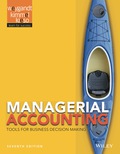
(a)
Cash flow is the monetary consideration (return or income) received by the business for its long-term capital investment.
Net present value method is the method which is used to compare the initial
To determine: The net present value based on the original estimates.
(b)
Net present value method:
Net present value method is the method which is used to compare the initial cash outflow of investment with the present value of its cash inflows. In the net present value, the interest rate is desired by the business based on the net income from the investment, and it is also called as the discounted cash flow method.
To determine: The net present value based on the revised estimates.
(c)
Net present value method:
Net present value method is the method which is used to compare the initial cash outflow of investment with the present value of its cash inflows. In the net present value, the interest rate is desired by the business based on the net income from the investment, and it is also called as the discounted cash flow method.
To determine: The net present value based on the original estimates with 10% of discount rate.
(d)
The
The internal rate of return method is one of the capital investment methods which determine the rate of return wherein the net present value of all the cash flows (both positive and negative) from an investment is zero. This method also called as the time-adjusted rate of return method, and it used to evaluate the different proposal’s expected rate of return.
To determine: The internal rate of return for the given proposa
Want to see the full answer?
Check out a sample textbook solution
Chapter 12 Solutions
Managerial Accounting: Tools for Business Decision Making
- What was the volume variance for sales revenue ?arrow_forwardFred needs $65,000 after tax in retirement income. If his expected average tax rate will be 21% and his marginal will be 27%, how much does he need before tax? a. $89,041. b. $82,278. c. $78,650. d. None of the above. e. $82,550.arrow_forwardPlease explain the solution to this general accounting problem using the correct accounting principles.arrow_forward
- Principles of Accounting Volume 2AccountingISBN:9781947172609Author:OpenStaxPublisher:OpenStax College
 EBK CONTEMPORARY FINANCIAL MANAGEMENTFinanceISBN:9781337514835Author:MOYERPublisher:CENGAGE LEARNING - CONSIGNMENT
EBK CONTEMPORARY FINANCIAL MANAGEMENTFinanceISBN:9781337514835Author:MOYERPublisher:CENGAGE LEARNING - CONSIGNMENT

